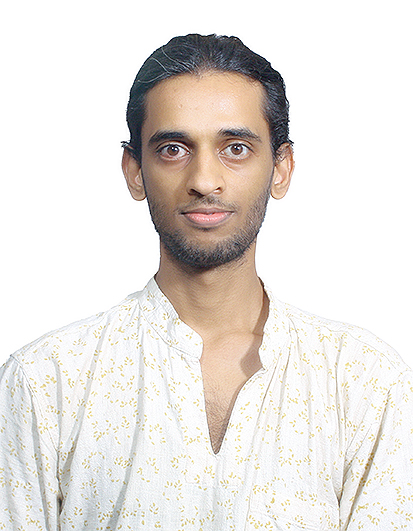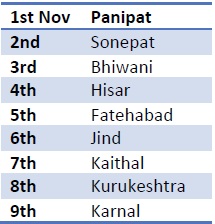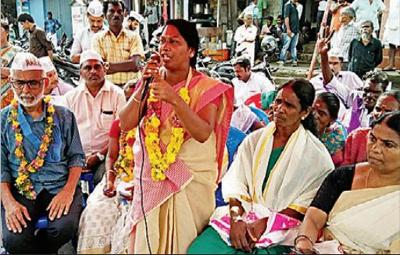Bhartrhari Srinivasan
The idea of reading Karakku was inspired by anger and, to a large extent, a feeling of suffocation in a system that erased caste and appropriated it depending on what was convenient. However, I soon realised that there does not exist as of yet, or at least I am not aware of, a language to express what it feels like to be in a space that has appropriated Dalit experience and lower caste experience in a very reductive manner. Therefore I will be using personal experience as I try to navigate through the text of Karakku and connect its readership to Patricia Williams’s parable of the Priest.
Initially, when I read Ambedkar’s Annihilation of Caste, I was inspired. It was as if the text lifted my life worth of trauma living as a child born of an intercaste marriage. I understood why some of my friends did not come to my house or get into my car. I understood why my grandmother would never eat from my mother’s food. I understood why my mother had to be isolated when she got her periods. I understood why my parents were never invited to family functions. It all made sense; it was related to caste. Caste was the root of all the problems, explaining my innermost sense of loneliness.
Caste, now that I look at my life retrospectively, was always there. When my paternal and maternal sides of the family ostracised my parents after their love marriage: that was the start of it all. It was an interesting marriage. My father was a brahmin, while my mother was a Reddiar. Reddiar went from being listed under the Most Backward Castes in Tamil Nadu to Backward Castes. The only reason my mother could get into the top positions in Software companies she occupies today was her education in IIT Madras. Which incidentally, she would not have got had it not been for reservation. Her family lived in poverty and struggled for food and to pay for my mother’s education. However, I do not read about anyone like that when I learn about cultural studies in my college.
All of the professors in my college come from upper-caste backgrounds. To them, education is just another asset to their CV. Another trophy to be collected as they all fight for the brass ring to see which pure borns are worthy. These are spaces only for the “meritorious.” Meritorious means that those who can pay over eight lakhs annually spend all their free time networking and studying and not worrying about menial work and labour. The ideal students in these spaces have spent years studying and doing extra-curricular activities and have mastered a particular culture. Merit then becomes how much money and resources the student had access to.
Thus, when Patricia Wiliams talks about “a society of priests who built a Celestial City with gates secured by word-combination locks (1)”, I read in it the Brahmanical priests that have for millennia held the monopoly of education.
These “…priests were masters of the Word and, within the City, ascending levels of power and treasure became accessible to those who could learn ascendingly intricate levels of Word Magic (Williams 1).” These priests created legal codes that subjugated the lower castes. The laws they created, observed in Manu Smriti and other Vedic codes, were vile and self-serving. The Brahmin was the centre of all legal punishments, and he was beyond punishment, and any pain or malaise inflicted on him was the greatest wrong one could commit (Shobana 58-59). The culture was produced where the Brahmin was at the top of the caste hierarchy and benefitted from the social capital of being at the top of the social hierarchy.
However, this is not the history we study in our education spaces. On the contrary, we see our spaces filled with brahmin scholars joking about how the brahmins are the most oppressed groups in our country.
I was reading Twitter the other day and was seeing tweets about how Brahmins need to buy an island and go there since it was not safe for them here. I heard people in my paternal side of the family talk about how the brahmins are beaten, how they are forced to eat “non-veg” food, and how everybody is biased against them. Well, how convenient since brahmins and other Savarna also just happen to hold all the top positions in various sectors in our country (Saxena, Teltumbde 137-138, and Gochhayat 75). Now they get to play the victim as well.
They have always populated educational spaces, as teachers creating brahminical historiography celebrating the Brahmin-Baniya heroes, and excluding Ambedkar, Phule, Periyar, and other anti-caste scholars and activists (Sundar 35-36 & Shepherd 11-16). In my college, almost all of the buildings are named after brahminical heroes. Chanakya, Aryabhatta, Tagore, Chandragupta, Kasturba, and Arjuna. We have one small building named Kabir, the only non-Savarna name on the whole campus. Despite the college being in Maharashtra, Phule and Ambedkar or any other countless Bahujan activists scholars are conspicuously missing.
Thus the fire that Annihilation of caste had lit in me has slowly started to burn out. When I speak about why Ambedkar is missing on campus, I get put down because I am but a student, and I do not understand the complexity of academia. I try to vocalise how Ambedkar is important to our history and how pertinent his critique of Hinduism and Brahmanism is to our contemporary society.
However, the academics at my college beg to differ. Ambedkar was not a historian, you do not understand what he means by Brahminism, and other ways to dismantle my critique of casteism are deployed. Students came up to me and demanded to know what was wrong with me and why I see caste in everything. I was accused by Savarna women of being patriarchal and narrow-sighted. I realised that as a student, only so much of my thoughts and ideas would be tolerated when it comes to caste. A deep fear has set in that with just one word too strong or one action too radical, and the wrath of the cultural machinery will be felt.
When I brought up the eating segregation on the campus, I was told that there is no eating segregation and I should stop talking about it. These are the spaces in which we talk about Dalit Literature. This is the space where we talk about Karukku.
I find Patricia Williams quite helpful to talk about caste in Savarna spaces. Her revolutionary idea of introducing personal experience as a mode of intervention has inspired the way I have approached this essay. I feel that my deep discomfort of reading Karukku in my college does not yet have a language outside of my experience.
Thus I sit here, after being possibly suspended for putting out a bowl of condoms, in an attempt to start a conversation about safe sex, because of the multiple pregnancies scares and lack of access to protection on campus, thinking about how futile this entire exercise feels.
When Bama talks about how the convent nuns cheated and exploited students, I felt anger and shame for being part of such an oppressive system (102-103). However, when I talked to my classmates, they felt pity for Bama and other Dalit students. I read police brutality, anti-reservation, deep-rooted casteism, brahmin hegemony, and the caste-class dialectic when I read Bama’s Karukku. However, the introduction of the book by the translator Lakshmi Holmstrom reveals a completely different picture.
To Lakshmi Holmstrom, the radicalness of Karukku ends at Bama’s non-Sanskritised use of Tamil (xix-xx). Lakshmi Holmstrom goes on to say that,
“Karukku was written out of a specific experience, the experience of a Tamil Dalit Christian woman. Yet it has universality at its core which questions all oppressions, disturbs all complacencies, and, reaching out, empowers all those who have suffered different oppressions (xiv).”
However, what comes under the different forms of oppression? Why does Lakshmi Holmstrom not talk about institutions that she herself is part of, which feed into the oppression? Why does Lakshmi Holmstrom not talk about police brutality, casteism in educational spaces or read Karukku as a narrative about the Brahmin hegemony?
We will never know. These questions seem to only start endless debates around caste erasures, and I become the oppressor and they the oppressed. By reading Bama’s narrative and just focusing on Bama, Karukku becomes a narrative of the self-discovery and trauma of Bama (xiv).
Holmstrom obviously reads the text in a very reductive way when she says,
“The tension throughout Karukku is between the self and the community: the narrator leaves one community (the religious order) and affirms her belonging to another (a Dalit community, particularly of women) (Holmstrom xviii).”
The lens of her reading seems to be focused on the Dalits. It is consistent since she puts this text in the genre of Dalit literature. Therefore this text is not about the Savarna institutions that govern and produce the caste experience of the Dalits. This story is about the struggles and tribulations of the Dalits, which renders the text toothless, and primes it for co-option into Savarna culture. Because the readership of Karukku has been primed to read this as a text of trauma, and atrocity, one of the only ways caste gets talked about in the Media, it is now ready to be accepted into the Savarna folds. The majority of the actors in Karukku are all from lower castes. It is the OBC’s that oppress the Dalit community, and the “upper castes” in the books are not the Dwijas. Therefore the caste does not come to the door of the Savarna academics in the urban setting.
The idea of Dalit literature is itself quite an interesting phenomenon. It seems like that the only way that a Dalit person can exist in Savarna circles is in the self-deprecating way, which is a Dalit body as a site of atrocity and trauma. Their stories are not read as a story of the oppressor; rather, it is the story of the oppressed. Therefore the reading of the Dalit narrative as the stories of the oppressed, we absolve any responsibility from the institutions and the communities that reproduce their oppressive structures. These stories become little more than watching with voyeuristic pleasure a life of struggle and reconciliation. Or it is read as a narrative of the oppressed and how pathetic their situation has become. It then becomes an act of pity and that these people need to be saved. It does not encourage self-introspection.
The reason why the Savarna audience is so insulated from caste is the spaces they have created for themselves. This is why I tried my best to talk about the Savarna college in which I study. They do not have to deal with caste, and caste is ignored. Therefore when narratives of caste come to their vision, it naturally becomes a story of aliens. It becomes a story of poor, impoverished, of the less fortunate, far removed from their reality. Therefore, the only emotions that can be raised in these spaces are either that of pity, or sick pleasure, as there is no understanding of their role in the caste system.
When one compares this to the preface of Dr Ambedkar’s work Riddles in Hinduism, the appropriative forces of Savarna politics become quite apparent. People had to die and protest for years to get Dr Ambedkar’s work published, and the initiative taken by Dalits in preserving Ambedkar’s work is nothing short of miraculous (Ajnat 8-10).
The reason Ambedkar could not be appropriated the same way Bama’s Karukku could be that Ambedkar rightly located the oppression at the Brahmanical institutions. His work Riddles of Hinduism asks questions about the nationalist movement and the politics of the Hindu identity. Therefore we see how the Savarna media reacted to a Dalit who dared to question the Brahminical masters.
We see political cartoons where Dr Ambedkar is depicted as a destroyer of women, as a midwife, as a neo-brahmin, as a disfigured monster, etc. While Gandhi, Nehru and their Brahmin-Baniya cohorts are depicted to be flawless and saviours of the nation, the only mainstream political representation of Ambedkar is vile and filled with casteist abuse (Sundar 35-37, 240, 247, 252, 263,299, 323, 326).
Therefore when erasure and appropriation do not work with Dalit writing, the media and academics resort to the vilest forms of attack. Bama’s Karukku thus needs to be read in this light.
Despite its potential to critique the Brahminical institutions, the Savarna allies have tried hard to frame it in the most toothless way possible. The translator sets the tone by focusing the narrative on being about Bama and Dalits and absolving the Brahmanical institutions of any responsibility.
The location of the text also plays a crucial role in its interpretation. The text was being read in a Savarna college. It becomes challenging to have responsible reading of the text. Dalits are severely unrepresented in this college. So the politics of the readership becomes crucial to the reading of the text.
Borrowing the parable of Williams to paint a more illustrative picture and fill the word count. The Priests now have used their power over the words to frame the words of the mortals submerged in the celestial city. The drowned mortals are another trophy to be collected in the quest for the Brass ring of the Priests, to dethrone other Priests. The drowned when they make a move to enter the Celestial city the divine weapons are deployed with impunity. Only their stories, the atrocities, and trauma enter the city, to become tools and political weapons in the bizzare exclusive game.
~
Work Cited
Ajnat, Surendra. Preface. Riddles in Hinduism by Ambedkar, B.R., Samyak Prakashan, 2017, pp. 8-9.
Gochhayat, Rajanikanta. “Issues with 10% Upper Caste Reservation: ‘Politics of presence’ or ‘Electoral strategy’?”, EWS: The Quota to end all Quotas – Ambedkar, The Shared Mirror, August 2021
Holmstrom, Lakshmi. Introduction. Karukku, by Bama, translated by Lakshmi Holmstrom, Oxford India Paperbacks, 2014, pp xv-xxi
Holmstrom, Lakshmi. Translator’s Note to the Second Edition. Karukku, by Bama, translated by Lakshmi Holmstrom, Oxford India Paperbacks, 2014, pp xiii-xiv
Shobana, Nidhin. “The Cost of a Poor Brahmin: Notes from History,” EWS: The Quota to end all Quotas – Ambedkar, The Shared Mirror, August 2021
Sundar, Unnamati Syama. No laughing matter, Navayana, 2018
Saxena, Namit. “Disproportionate representation at the Supreme Court: A perspective based on Caste and Religion of judges” Bar and Bench, May 2021 https://www.barandbench.com/columns/disproportionate-representation-supreme-court-caste-and-religion-of-judges
Williams, Patricia. J. The Alchemy of Race and Rights: Diary of a Law Professor, Harvard University Press, 1991, pp 1.
~~~
Bhartrhari Srinivasan is a student trying to survive!









